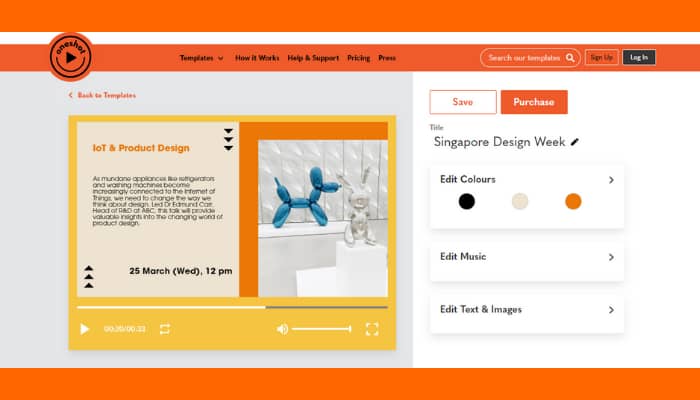Singapore – With more and more small and medium enterprises (SMEs) now migrating towards creating a digital presence, presentable yet simplified video editors are an essential for them to create visual-appealing multimedia for their growing number of online users. Hence, marketing technology software-as-a-service (SaaS) video tool Oneshot has released their latest simplified video editor catered to SMEs looking for easy-to-use video editing tools.
Said video editor tool creates personalized videos using a simple point-and-click interface, without the heavy lifting of tedious video editing. This is further supported by various pre-built and professionally-designed templates to cater to the uses of numerous businesses and industries.
Oneshot offers three affordable packages to choose from: Lite(S$39) for three videos, Pro(S$159) for 20 videos, and Ultimate(S$120) for 20 videos per month. The video maker does not offer stock images or footage in an effort to encourage brands to use their own assets in creating authentic videos for their various personal or business uses.
With an objective to empower SMEs and small businesses during this time of digitalization, Oneshot offers its service at an affordable price point, to allow anyone to access and create videos for their marketing and advertising needs.
“We realize that many businesses, especially SMEs, are inconsistent in asserting their presence online. Many are still tightening purse strings or fighting to remain afloat, and hiring a creative agency is an expensive luxury. However, cutting down on the marketing budget affects a business’ brand presence and reduces the opportunity to boost online traffic and sales,” said Cindy Chay, co-founder of Oneshot.
She further added that the service aims to bridge the gap of presentable media and affordable video editing strategies, which in turn provides SMEs and other smaller companies access to perfectly optimized videos at an affordable price. She adds that it enables its users, whether complete beginners or individuals with limited video editing knowledge, to create pro-grade videos at their fingertips.
Meanwhile, Christantio Giovanni, co-founder at Oneshot, shared that we are currently met with many different types of videos and advertisements from a wide range of industries, such as F&B, retail, fashion and even education, and that thhis exciting selection of variety has inspired Oneshot to develop hundreds of pre-built and professionally designed templates, as we encourage designers and animators to take full control and add their personal touches.
“Every aspect of the video template selection is born out of unrestrained creativity, whether it be for creating testimonials, instructional videos or even sales and promotional ads. We take pride in constantly updating the platform and are passionate in developing new video templates that bring forward the persona of SMEs and businesses in every industry,” Giovanni said.
The video templates offered by Oneshot comes in an abundance of choices, all catered for businesses to meet their marketing goals, whether it be to gather attention from the audience, influence higher conversion rates or actively sell products. Furthermore, for video-making beginners or individuals with limited video editing knowledge the tool promises to take care of the heavy lifting such as the design and animation portions in order to save time.






